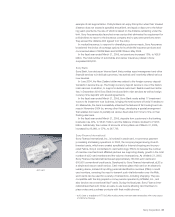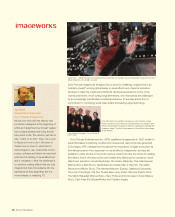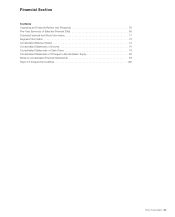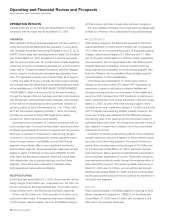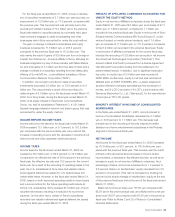Sony 2005 Annual Report Download - page 32
Download and view the complete annual report
Please find page 32 of the 2005 Sony annual report below. You can navigate through the pages in the report by either clicking on the pages listed below, or by using the keyword search tool below to find specific information within the annual report.
Sony Corporation 29
Spider-Man 2, winner of the 2005 Academy Award® for Best Achievement in Visual
Effects, demonstrated Imageworks’ drive to surpass its previous accomplishments—
a challenge of the highest order. In Spider-Man 2, the hero gets up close and personal
with the tentacled villain, Doctor Otto Octavius—“Doc Ock.” Spider-Man engages in
extensive hand-to-hand combat with both real and virtual versions of Doc Ock, which
required complex and detailed CG versions of both characters. The reality of Spider-
Man’s moves and reactions to attacks and blows from Doc Ock’s tentacles required
a complete rethinking of the Spider-Man character, with even higher expectations for
the animators. Both digital characters showcased the state of the art in digital humans,
with lifelike movement and appearance, especially in the rendering of skin, hair and
fabric. In the original Spider-Man, both the title character and the villain were masked.
In Spider-Man 2, we see their individual faces close up, which required the development
of a new CG skin technology pipeline.
Jerome Chen
Senior Visual Effects Supervisor,
Sony Pictures Imageworks
I help filmmakers tell their stories. Often
the success of their story requires some-
thing that hasn’t been done before. My
job is to figure out how to do it, ignoring
that at first glance it might seem impos-
sible. This was the case last year with
The Polar Express. Film director Robert
Zemeckis was determined to faithfully
bring the visual style of the popular
children’s book to the big screen. He
didn’t see it as a live-action film, but he
also didn’t want to create the movie with
conventional animation. What he wanted
was something in between, a technique
that would transform an actor’s perfor-
mance into a digital character. When
faced with a daunting challenge, I usually
think of what would be the most simple
and intuitive approach. With The Polar
Express, I thought the simplest way to
get the best result was to capture the
details of the actor’s face and body at
the same time. We developed a new
performance-capture technique called
Imagemotion, in which the complete
performance is captured together and
later integrated by our digital artists into
the CG characters and environments.
The process also enabled Zemeckis to
stage his scenes with multiple actors,
all of whom could be performance-
captured simultaneously. Scenes could
be played just as they would in live
action, with all of the spontaneity and
energy that comes with a live perfor-
mance. What was simple to conceive
was incredibly difficult to accomplish, but
the results opened the door to a new
way of making movies.
A detailed digital city in Spider-Man 2, far more extensive than anything seen in Spider-Man, enabled the film-
makers to stage scenes across an urban landscape. This was most spectacularly revealed in the scenes in
which Spider-Man flies through the city and throughout a sequence where fully digital characters Spider-Man
and Doc Ock fight onboard a speeding train.
Sony Corporation 29
Spider-Man 2 – Motion Picture © 2004 Columbia Pictures Industries, Inc. All rights reserved. Spider-Man Character ® & © 2004
Marvel Characters, Inc. All rights reserved.
S ONY AR -E 0629 Adobe PageMaker 6.0J /PPC



